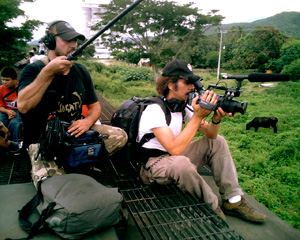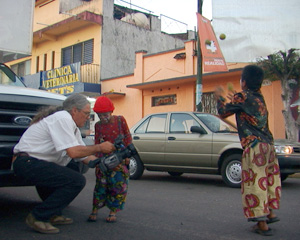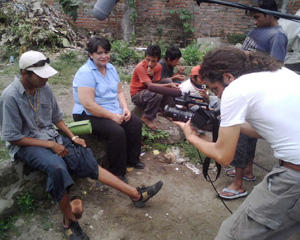The Making of the Film
 How did you meet your interview subjects?
How did you meet your interview subjects?
We met our subjects in many different ways’ mostly in immigration detention centers, by the railroad tracks, and other locations where migrants converged to travel north. We felt it was extremely important to find families of children who had died migrating in the Sonora Desert, to make two points: that children are in grave danger when they migrate through Mexico, and that this practice is an urgent child welfare issue.
What aspect of the children’s journey surprised/shocked you most? Were you surprised by their age, conditions, and circumstances?
After researching this story for so long, I was not surprised or shocked by the circumstances of child migrants’ lives. However, I was taken by their utter commitment to pursing their dreams of reaching the United States. I did hold my breath when watching our young subjects hopping the trains. Sometimes, they treated the train like a playground; jumping from boxcar to boxcar, jumping off the train to run alongside it, only to jump back on again – just for laughs. They really did not have a “healthy fear” of freight trains as a dangerous means of travel.
 What kind of impact did your presence have on the journey?
What kind of impact did your presence have on the journey?
We wanted our impact to be minimal. As observers, our job was to document their lives while traveling with them. However, since our subjects were children, we made it a point to remind them how dangerous the road ahead could be, and we offered to help connect them with migration officials if they wanted to go home.
The realm we were filming in was full of smugglers, gang members, and corrupt officials. As a crew, we were always mindful of how our child subjects could potentially be put in danger by the presence of our cameras and ourselves. On several occasions, we decided not to travel with children when threats towards us were made.
How long was the filming? Were there gaps in between shoots? How did you track your subjects?
This film took six years to complete, and there where many gaps in between shoots. I first pitched this film idea in early 2003, and received a development grant from the Sundance Documentary Fund. In November 2004, I traveled to Mexico to research, scout locations, film child subjects, and edit a trailer for fundraising purposes. While filming in 2004, I was struck by the huge multitudes of migrants that had crossed over from Guatemala into Tapachula, Mexico, and were waiting on the tracks to hop freight trains going north. This fact made it very easy for us to meet potential subjects. Unfortunately, the development money ran out and I was forced to return to Mexico City and cut a trailer with the footage I had.
 Shortly after HBO came on board, I decided to search for an executive producer. That same year, Lianne Halfon, Russell Smith and John Malkovich of Mr. Mudd stepped in. Fortunately for us, Mr. Mudd agreed to executive produce, and while they worked tirelessly to find investors, filming was halted for a year and a half. Because of Mr. Mudd’s involvement, I was able to return to Mexico to complete principal filming. In 2006, investors were found, and I also received a Fulbright Fellowship to Mexico for Filmmaking. This 11-and-a-half-month fellowship began in the fall of 2006, and helped me greatly by providing: 1) a stipend that covered my living expenses, and 2) the most important factor – a work visa, which granted me the extended time in Mexico to complete filming.
Shortly after HBO came on board, I decided to search for an executive producer. That same year, Lianne Halfon, Russell Smith and John Malkovich of Mr. Mudd stepped in. Fortunately for us, Mr. Mudd agreed to executive produce, and while they worked tirelessly to find investors, filming was halted for a year and a half. Because of Mr. Mudd’s involvement, I was able to return to Mexico to complete principal filming. In 2006, investors were found, and I also received a Fulbright Fellowship to Mexico for Filmmaking. This 11-and-a-half-month fellowship began in the fall of 2006, and helped me greatly by providing: 1) a stipend that covered my living expenses, and 2) the most important factor – a work visa, which granted me the extended time in Mexico to complete filming.
Because there were many delays in filming, most of the time we would be forced to begin again with new child subjects. Also, after Hurricane Stan struck in 2005, the landscape in Tapachula, Mexico irrevocably changed. This hurricane destroyed infrastructure, train tracks, and wiped out the train bridge that trains took north. Therefore the trains stopped running and migrants were forced to find other dangerous routes to cross. Partial funding arrived in January 2007, but by the time we returned to film, it was much harder to connect with potential subjects. Our shooting schedule lasted three weeks when bureaucratic and contractual delays forced myself, and my crew to suspend filming and leave the field again.
 Six months later, in July 2007, filming continued, and we had to find new child subjects. Also, the train company that operated in southern Mexico officially folded. We did not realize it at the time, but the train we took with our new child subjects was the last one that went north. Filming halted once again for three weeks, but we were able to follow up with our child subjects in mid-August through September, and again in November 2007.
Six months later, in July 2007, filming continued, and we had to find new child subjects. Also, the train company that operated in southern Mexico officially folded. We did not realize it at the time, but the train we took with our new child subjects was the last one that went north. Filming halted once again for three weeks, but we were able to follow up with our child subjects in mid-August through September, and again in November 2007.
Your crew has incredible access within the governmental agencies in Mexico. How were you able to get clearance?
Gaining access and permissions from governmental officials and various agencies took many months to obtain. I was very fortunate in meeting Alejandra Liceaga, the film’s production manager. She was instrumental in making those initial contacts, building support, and pursuing the permissions until we finally received them.
I must say that we received lots of support and good will from Central American and Mexican officials, who really believed in the story we were trying to tell, and so the accesses were granted.
What is your intended impact for the film?
To make the public aware of the realities of child migration, and to provide a greater understanding of not only how but also why children are so driven to make this journey alone. Many child migrants are trying to find relatives, so one challenge is how to provide laws that migrating children and their parents can be reunified safely. Lastly, and very hopefully, that this film will serve as a catalyst to promote a dialogue that leads to creating humane, immigration policy reform in the United States.